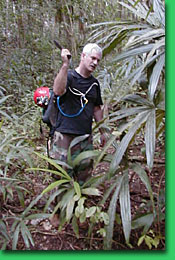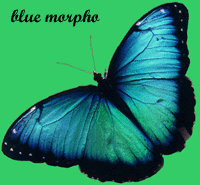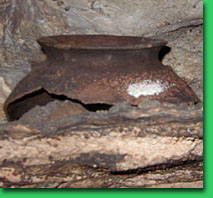 ur team is exploring in one of the few unspoiled rain forests in the world. Every day we see unique plants and animals that are wonderful. Last night I took my shower outside, on the edge of a 200-foot cliff overlooking a beautiful valley. Howler monkeys were screaming in the forest--they sounded like the T. rex in Jurassic Park! ur team is exploring in one of the few unspoiled rain forests in the world. Every day we see unique plants and animals that are wonderful. Last night I took my shower outside, on the edge of a 200-foot cliff overlooking a beautiful valley. Howler monkeys were screaming in the forest--they sounded like the T. rex in Jurassic Park!
Speaking of Jurassic Park, many of the creatures we encounter in the jungle seem to be from times long since past. Yesterday we found a hermit lizard sunning himself on a jungle path. Hermit lizards look something like the Velociraptor dinosaurs that attacked in packs in the movie. They run on their hind legs when they are scared. The one we found, though, was very calm. He even let us pick him up with our hands!
|
 o get to the caves, we have to cut through the jungle with machetes. We have to learn which trees not to cut, as some are poisonous. The chechem tree looks like other trees in the jungle, but the black sap in the bark causes a painful skin reaction ten times worse than the worst poison ivy! The jungle has some helpful trees as well. For example, the gumbolimbo tree is the cure for the chechem skin rash. If you cut some of the bark of the gumbolimbo tree and rub the sap on the rash, it will go away in a few days. o get to the caves, we have to cut through the jungle with machetes. We have to learn which trees not to cut, as some are poisonous. The chechem tree looks like other trees in the jungle, but the black sap in the bark causes a painful skin reaction ten times worse than the worst poison ivy! The jungle has some helpful trees as well. For example, the gumbolimbo tree is the cure for the chechem skin rash. If you cut some of the bark of the gumbolimbo tree and rub the sap on the rash, it will go away in a few days.
We move through the jungle very quickly when we are on a regular trail. Our team carries all of the equipment we need for exploration in our backpacks. The packs weigh about 60 pounds and feel heavier and heavier as the day goes on! Our bags are filled with rope, medical kits, climbing equipment, compasses, food, and lots of water canteens. Most importantly, we take along a global positioning system (GPS) unit that receives signals from a satellite to tell us where we are in relation to the possible caves.
|  |
 t is while resting that we can see the animals and signs of life in the jungle much better. We saw the paw prints of a jaguar one day when we were eating lunch. Jaguars are very rare now because they have been hunted almost to extinction. t is while resting that we can see the animals and signs of life in the jungle much better. We saw the paw prints of a jaguar one day when we were eating lunch. Jaguars are very rare now because they have been hunted almost to extinction.
The jungle is full of beautiful birds and butterflies. My favorite butterfly is the blue morpho. It is the size of both of your hands put together and is brilliant blue in color. We've seen at least five different kinds of hummingbirds during our travels, as well.
There are lots of creepy-crawlers in the jungle. I saw a black viper snake in one cave, but I didn't mess with him! Fer de Lance snakes are common in this part of Belize, too. They are very poisonous snakes. Last year I stepped on one in the same creek we walked through yesterday!
|  |
I found a huge scorpion near my towel when I was taking a shower in the dark two nights ago. Luckily I had a flashlight with me and was able to get my towel without making him angry. He crawled off into the jungle one way, and I went the other.
Our worst enemy in the caves is the assassin beetle. They hang out in small cracks in cave entrances, feeding on bats and other small animals. They are about two inches long and very ugly!! The problem is that they sneak up on you and inject their needle nose into your skin, kind of like a mosquito. You can't feel this happen because they have a chemical that numbs the skin like the novacaine your dentist uses. They suck your blood like a mosquito, but the danger is that they carry a parasite that causes a disease called Chagas. Charles Darwin may have died from Chagas disease.
 ur team is trying to discover caves in the jungle that were used by the ancient Maya, a group of people who had an advanced civilization that began about 3,000 years ago and faded away about 1,000 years ago. Descendants of the Maya still live in Central America, and a few still speak the original Mayan language. ur team is trying to discover caves in the jungle that were used by the ancient Maya, a group of people who had an advanced civilization that began about 3,000 years ago and faded away about 1,000 years ago. Descendants of the Maya still live in Central America, and a few still speak the original Mayan language.
The ancient Maya believed in the afterlife and that caves were a watery underworld. They conducted rituals in the caves and left behind many objects like pottery vessels and stone knives. Some of the caves even have evidence of human sacrifice.
Archaeologists are trying to understand what the world of the ancient Maya was like, and to do this it is best to study sites that have not been disturbed by modern humans. This is why we are going to so much trouble to find new caves with evidence of ancient Maya rituals.
|  |
 art of our study is using satellites and radar to find cave entrances. The radar sensors are flown on an airplane, and they penetrate right through the jungle canopy. We are using this to identify possible cave sites. Then, using GPS devices and special maps, we can hack through the jungle to find them. Two days ago we used this technology. We climbed through the jungle for 4 hours using the GPS to lead us to the site. The radar pinpointed a small sinkhole within 1 meter!! art of our study is using satellites and radar to find cave entrances. The radar sensors are flown on an airplane, and they penetrate right through the jungle canopy. We are using this to identify possible cave sites. Then, using GPS devices and special maps, we can hack through the jungle to find them. Two days ago we used this technology. We climbed through the jungle for 4 hours using the GPS to lead us to the site. The radar pinpointed a small sinkhole within 1 meter!!
With the help of the latest technology, we can find out more about the ancient Maya culture.
CLICK HERE FOR THE NEXT UPDATE!
This update is dedicated to Alex Minkin, Sam Warner, and their fellow students in Asheville, North Carolina, and Debbie Szymanski and her students, also in Asheville. |
|





 ur team is exploring in one of the few unspoiled rain forests in the world. Every day we see unique plants and animals that are wonderful. Last night I took my shower outside, on the edge of a 200-foot cliff overlooking a beautiful valley. Howler monkeys were screaming in the forest--they sounded like the T. rex in Jurassic Park!
ur team is exploring in one of the few unspoiled rain forests in the world. Every day we see unique plants and animals that are wonderful. Last night I took my shower outside, on the edge of a 200-foot cliff overlooking a beautiful valley. Howler monkeys were screaming in the forest--they sounded like the T. rex in Jurassic Park! o get to the caves, we have to cut through the jungle with machetes. We have to learn which trees not to cut, as some are poisonous. The chechem tree looks like other trees in the jungle, but the black sap in the bark causes a painful skin reaction ten times worse than the worst poison ivy! The jungle has some helpful trees as well. For example, the gumbolimbo tree is the cure for the chechem skin rash. If you cut some of the bark of the gumbolimbo tree and rub the sap on the rash, it will go away in a few days.
o get to the caves, we have to cut through the jungle with machetes. We have to learn which trees not to cut, as some are poisonous. The chechem tree looks like other trees in the jungle, but the black sap in the bark causes a painful skin reaction ten times worse than the worst poison ivy! The jungle has some helpful trees as well. For example, the gumbolimbo tree is the cure for the chechem skin rash. If you cut some of the bark of the gumbolimbo tree and rub the sap on the rash, it will go away in a few days.
 t is while resting that we can see the animals and signs of life in the jungle much better. We saw the paw prints of a jaguar one day when we were eating lunch. Jaguars are very rare now because they have been hunted almost to extinction.
t is while resting that we can see the animals and signs of life in the jungle much better. We saw the paw prints of a jaguar one day when we were eating lunch. Jaguars are very rare now because they have been hunted almost to extinction.

 art of our study is using satellites and radar to find cave entrances. The radar sensors are flown on an airplane, and they penetrate right through the jungle canopy. We are using this to identify possible cave sites. Then, using GPS devices and special maps, we can hack through the jungle to find them. Two days ago we used this technology. We climbed through the jungle for 4 hours using the GPS to lead us to the site. The radar pinpointed a small sinkhole within 1 meter!!
art of our study is using satellites and radar to find cave entrances. The radar sensors are flown on an airplane, and they penetrate right through the jungle canopy. We are using this to identify possible cave sites. Then, using GPS devices and special maps, we can hack through the jungle to find them. Two days ago we used this technology. We climbed through the jungle for 4 hours using the GPS to lead us to the site. The radar pinpointed a small sinkhole within 1 meter!!